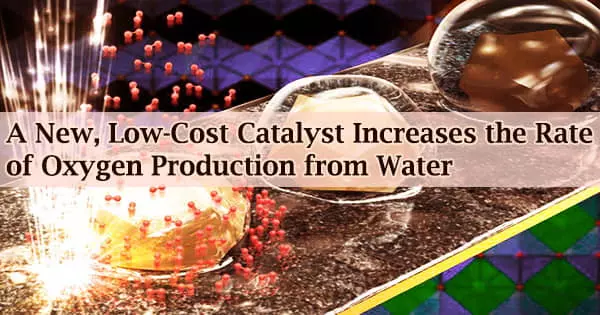Multiple ways to producing alternative transportation fuels are based on an electrochemical mechanism that splits apart water molecules to produce oxygen. However, a catalyst material is required to enable this reaction, and current versions require the usage of rare and expensive materials such as iridium, limiting the potential of such fuel production.
Researchers at MIT and other institutions have discovered a brand-new form of catalyst material called a metal hydroxide-organic framework (MHOF), which is made up of cheap and plentiful components.
Engineers may fine-tune the structure and content of the catalyst to meet the needs of a specific chemical process, and it can then match or exceed the performance of conventional, more expensive catalysts.
MIT postdoc Shuai Yuan, graduate student Jiayu Peng, Professor Yang Shao-Horn, Professor Yuriy Román-Leshkov, and nine other researchers published their findings in the journal Nature Materials.
One of the common reactions in the electrochemical synthesis of fuels, chemicals, and materials is oxygen evolution. These processes include the production of hydrogen as a byproduct of oxygen evolution, which can be used directly as a fuel or used in chemical reactions to produce other transportation fuels; the production of ammonia, which can be used as a fertilizer or chemical feedstock; and carbon dioxide reduction to reduce emissions.
But without help, “These reactions are sluggish,” Shao-Horn says. “For a reaction with slow kinetics, you have to sacrifice voltage or energy to promote the reaction rate.”
These catalysts are all relying on expensive materials or late transition metals that are very scarce, for example iridium oxide, and there has been a big effort in the community to find alternatives based on Earth-abundant materials that have the same performance in terms of activity and stability.
Yuriy Román-Leshkov
Because of the extra energy input required, “The overall efficiency is low. So that’s why people use catalysts,” she says, as these materials naturally promote reactions by lowering energy input.
But until now, “these catalysts are all relying on expensive materials or late transition metals that are very scarce, for example iridium oxide, and there has been a big effort in the community to find alternatives based on Earth-abundant materials that have the same performance in terms of activity and stability,” Román-Leshkov says.
The team claims to have discovered materials with precisely that combination of properties. Other groups have looked into using metal hydroxides, such as nickel-iron hydroxides, according to Román-Leshkov.
But such materials have been difficult to tailor to the requirements of specific applications. Now, though, “The reason our work is quite exciting and quite relevant is that we’ve found a way of tailoring the properties by nanostructuring these metal hydroxides in a unique way.”
Metal-organic frameworks (MOFs) are a type of crystalline structure made up of metal oxide nodes linked together by organic linker molecules. The team drew inspiration from studies on a related class of substances known as metal-organic frameworks (MOFs).
The scientists discovered that by substituting the metal oxide in such materials with particular metal hydroxides, it was feasible to develop precisely tunable materials that were also stable enough to be used as catalysts.
“You put these chains of these organic linkers next to each other, and they actually direct the formation of metal hydroxide sheets that are interconnected with these organic linkers, which are then stacked, and have a higher stability,” Román-Leshkov says.
He claims that this offers numerous advantages, including accurate control over nanostructured patterning, exact control of the metal’s electrical characteristics, and higher stability, allowing them to withstand lengthy periods of operation.
The performance of the catalysts was “surprising” when the researchers tested them, according to Shao-Horn. “It is comparable to that of the state-of-the-art oxide materials catalyzing for the oxygen evolution reaction.”
These materials should be at least 100 times cheaper than present catalysts, they claim, despite the fact that the team has not yet completed a detailed economic analysis.
According to Shao-Horn, this family of materials “really offers a new space to tune the active sites for catalyzing water splitting to produce hydrogen with reduced energy input,” to match the exact needs of any chemical process that requires such catalysts.
Peng claims that by substituting alternative metals for nickel in the compound, the materials can deliver “five times greater tenability” than existing nickel-based catalysts. “This would potentially offer many relevant avenues for future discoveries.”
The materials can also be made into ultra-thin sheets that can be coated onto another material, substantially lowering the system’s material costs.
The materials have only been tested in small-scale laboratory test devices so far, and the team is currently working on scaling up the process to commercially relevant scales, which could take a few years.
But the idea has great potential, Shao-Horn says, to help catalyze the production of clean, emissions-free hydrogen fuel, so that “we can bring down the cost of hydrogen from this process while not being constrained by the availability of precious metals. This is important, because we need hydrogen production technologies that can scale.”
Others on the study team came from MIT, Stockholm University in Sweden, SLAC National Accelerator Laboratory, and the Dresden-based Institute of Ion Beam Physics and Materials Research. The work was supported by the Toyota Research Institute.





